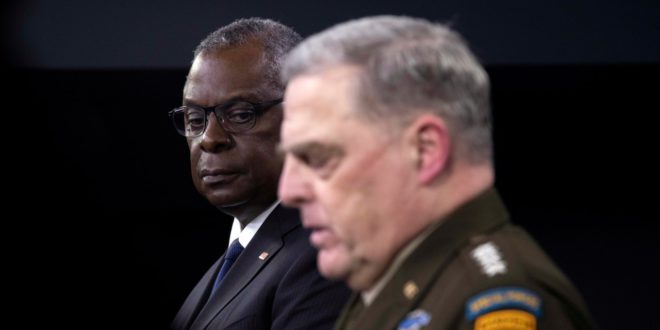
1. Sharp Decline in Trust and Confidence in the U.S. Military
For the first time in our survey, a minority of Americans—only 45%—report having a great deal of trust and confidence in the military. Alarmingly, this is down 25 points in the last three years. Increasing numbers of Americans say they have little or not much confidence in the military, which is up 15 points in the last three years. Those reporting some confidence have grown by 10 points.
Trust and confidence in the military is down across the major demographic subgroups, including age, gender, and party identification. Since 2018, those reporting the highest level of confidence in the military have fallen among Republicans by 34 points to 53%, Democrats by 17 points to 42%, and Independents by 28 points to 38%. The highest level of confidence is down 25 points among both men and women. And it is declining among all age groups as well, down 25 points among those over 65, by 26 points among those ages 45- 64, and 28 points among those 30-44.
Perhaps most troubling for recruitment in the all-volunteer force is that only a third (33%) of adults younger than 30 have high
confidence in the military, which is down 20 points since 2018. Confidence is lower among young Americans than any other demographic subgroup, including ideological, religious, ethnic, economic, or geographic region.
While the military continues to top the list of trusted institutions, the trend of declining trust is occurring more rapidly for the military than it is for other public institutions (Figure 1). The military has declined in trust by 25 points since 2018, while law enforcement has declined by 17 points from 50% to 33%. Those who say they have a great deal of confidence in the presidency declined by 9 points, from 28% to 19%, since 2018. The Supreme Court has also declined by 9 points, from 27% to 18%. Congress and the news media have had generally stable levels of trust and confidence since 2018.
November 2021
Trust and Confidence in U.S. Institutions Change in “A Great Deal” from 2018 to 2021
Reason for Declining Confidence in the Military
To understand more about the trend, a new survey question this year asked respondents to identify the main reason for their level of confidence in the U.S. military. Among those with high confidence, 29% said the reason for their level of confidence has to do with servicemembers; 15% said it has to do with the military protecting our nation and keeping us safe; and 11% said it has to do with our military capabilities, including equipment, weapons, or technology.
Among those with little or not much confidence in the military, their answers were more mixed. The most common answer was political leadership, at13%, followed by servicemembers and anything related to scandals within the military, both at 9%. Close behind at 8% were the military leadership and the concept that the military is too expensive or has the wrong priorities. While high trust and confidence seems to attribute to our men and women in uniform, the lack of confidence in our military seems to be more about a general negative sense than a predominate or precise reason.
Perceptions of Military Capabilities
Americans are also unsure about the military’s ability to perform its core responsibilities. Only slightly more than half (57%) have a great deal of confidence in the U.S. military’s ability to keep the country safe, while a quarter (26%) report some confidence and 14% have a little or not much confidence. Regarding its ability to win a war overseas, even fewer (42%) have a great deal of confidence, while 30% have some confidence and 23% have a little or not much confidence. Roughly the same numbers have a great deal of confidence (40%) in the military’s ability to act in a professional and nonpolitical manner, while 31% have some confidence and 25% have a little or not much confidence.
In 1976, Ronald Reagan admonished, “[W]e are number two in a world where it is dangerous, if not fatal, to be second best.” The American people believe we are now in that same dilemma. Overall, Americans are split between believing the U.S. military has the best capabilities in the world and that the military is only one of the best in the world (Figure 2). When asked how they think the U.S. military is doing compared to other militaries, 43% believe the U.S. military is the best in the world in overall capabilities, whereas 45% think it is only one of the best. The answers to this question track closely with trust and confidence in the military, as those with greater confidence in the military tend to think more highly of its capabilities. Still, when asked to identify which country has the best military, 69% named the United States. The second most common answer was China at 17%.
On specific capabilities, Americans are more likely to think the U.S. military is the best in the world when it comes to conventional weaponry, such astanks, battleships, and airplanes (45%) compared with only 27% who think it is the best in the world at cyber capabilities. There is particularly low belief in the relative strength of America’s military leadership and manpower. Only one-third (33%) think that the U.S. military leadership is the best in the world, whereas 42% think it is one of the best. There are slightly higher numbers for traditional manpower, such as enlisted servicemembers, with 36% believing the U.S. military is the best in the world, while 46% think it one of the best.
Only one-third (33%) believe the United States strikes the right balance between the use of the military and diplomacy. A roughly equal number(32%) believe America uses the military in too many situations where diplomacy would be better.
Perceptions of U.S. Government Spending
In terms of military funding (Figure 3), a plurality (39%) think the U.S. government spends about the right amount on defense, whereas roughly equal percentages think it spends too little (27%) or too much (26%). Among Republicans, equal percentages (42%) say the U.S. government spends too little or about the right amount on the military, with only 11% saying it spends too much.
Among Democrats, 45% say it spends too much, while 37% say it spends the right amount, and only 13% say it spends too little. When asked what the highest priority for increased funding should be, the military ranks fifth as a priority at 11%, behind healthcare (23%), border security (17%), education (15%), and infrastructure (14%). However, when asked what the next- highest priority for increased funding should be, the military jumps to the third position at 19%, behind only education (24%) and healthcare (21%). There is some partisan split on funding priorities, as Republicans rank the military second on their funding list, while it comes in lower for Democrats.
While 65% of Americans report being concerned about the threat of climate change, fewer (50%) support the U.S. military using part of its budget to address climate change—and 39% oppose it. There is a huge partisan gap on issue, with 78% of Democrats supporting and 67% of Republicans opposing. There is also an age gap on military funding to address climate change, with 66% of those under 30 supporting it, while 56% of those 65 or older opposing it.
2. Growing Ambivalence about U.S. Leadership in the World
Americans are becoming more ambivalent about the U.S. role in the world, as fewer people express support for active global leadership. Less thanhalf of Americans (42%) think it is better for the United States to be more engaged and take the lead when it comes to international events, which isdown by 9 points since February (Figure 4). Almost a third (30%) think that it is better for the United States to be less engaged and react to events—while 28% responded “it depends” or “don’t know” which is an increase of 6 points since February (Figure
5). Therefore, despite waning support for global engagement, this may not indicate a growing preference for isolationism overall. There does, however, seem to be a notable shift among Democrats. Those voters have moved from 59% believing the United States should be more engaged in February to only 46% in November. Correspondingly, the number of Democrats preferring less engagement jumped 100%. Among Republicans, the preference for global engagement now matches Democrats at 46%, with 30% preferring less engagement. The preference for internationalism grows among the more educated and among those ages 65 or older.
When it comes to the greatest threats we face, Americans are most concerned about cyberattacks (88%). Violence as a result of political division in the United States (85%) follows close behind, then terrorist attacks on the homeland (82%). Americans are also concerned about domestic terrorist attacks, as in terrorism committed by American citizens (79%). When asked if they think the greatest threats we face come from outside of the country or from within the country, 41% think they come from within, which is up 5 points since February 2021. Another 30% believe we face equal threats at home and abroad, which is also up 5 points since February. Only one in four (25%) think the greatest threats come from outside the country,which is down 10 points since February. Democrats are more likely to say that the greatest threats come from within (at 49%), while Republicans arerelatively evenly divided between believing the greatest threats come from
within the country (35%), from outside (31%), and from both equally (31%). Independents align more with Republicans on this point.
Despite this growing ambivalence about U.S. leadership and greater concern about threats from within, Americans still overwhelmingly support a forward-deployed military presence abroad. Nearly two-thirds (65%) believe it is better for the United States to maintain military bases around
Source: Reagan National Defense Survey, October 2019, February 2021, and November 2021
on this point as well, with 59% of Democrats, 56% of Independents, and 75% of Republicans support maintaining bases overseas.
 Soldier of Fortune Magazine The Journal of Professional Adventurers
Soldier of Fortune Magazine The Journal of Professional Adventurers






